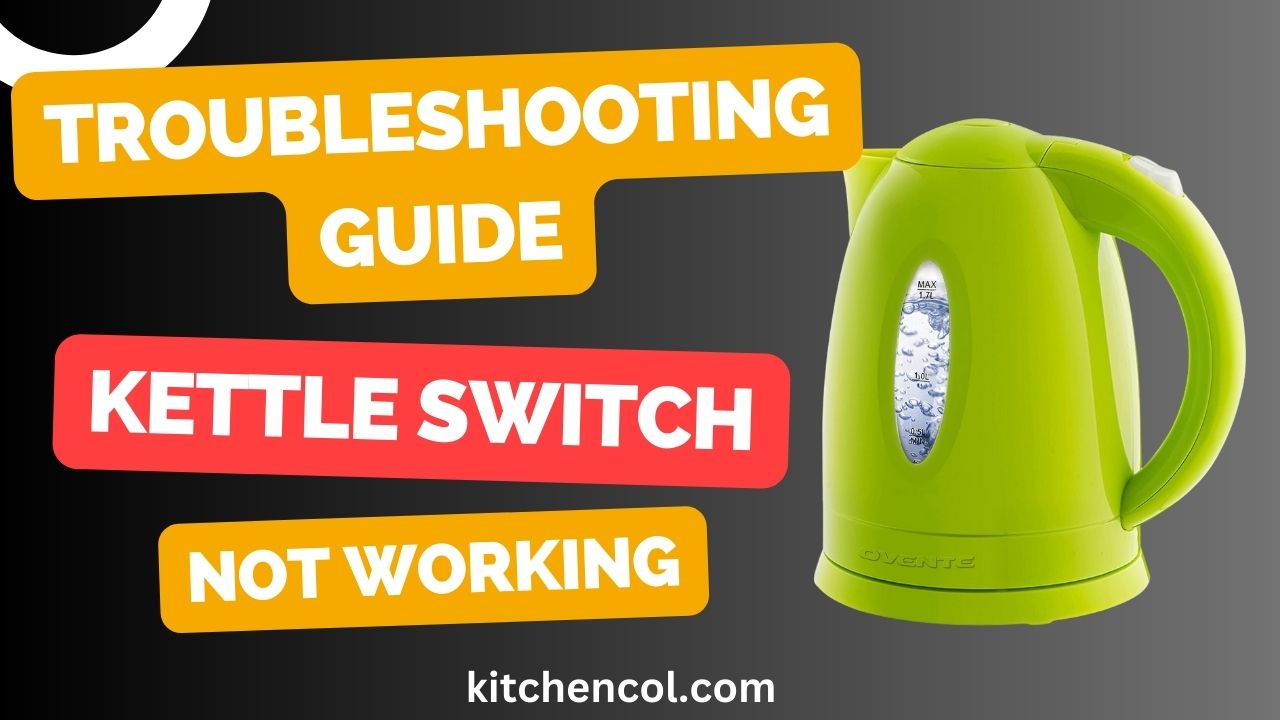Electric kettles have become an indispensable appliance in our daily lives, providing us with the convenience of quickly boiling water for our favorite beverages and culinary needs. However, like any electronic device, they can encounter issues over time, and one common problem that many users face is the kettle switch not working. If you find yourself in a situation where your kettle refuses to turn on, fret not!
In this troubleshooting guide, we will explore the possible causes of a faulty kettle switch and provide you with step-by-step solutions to get your kettle back up and running.
But before we delve into the fixes, let’s briefly understand the inner workings of electric kettles and the components responsible for their operation. Let’s get started on uncovering the solution to the perplexing problem of a kettle switch not working!
Understanding Electric Kettles
Electric kettles are simple yet efficient appliances designed to heat water quickly and safely. They have become a staple in kitchens worldwide due to their convenience and time-saving capabilities. To better troubleshoot issues with the kettle switch, it’s essential to have a basic understanding of how these appliances work and the key components involved.
How Electric Kettles Work:
Electric kettles work on the principle of converting electrical energy into heat energy. Inside the kettle, there is a heating element made of a resistive material, usually a coiled wire or a flat heating plate. When the kettle is plugged into an electrical outlet and the switch is turned on, current flows through the heating element, causing it to heat up rapidly.

Components of an Electric Kettle:
i. The Heating Element: As mentioned earlier, the heating element is the heart of the electric kettle. Its quick heating ability is what makes electric kettles so efficient.
ii. The Thermostat: To prevent the kettle from overheating and causing damage or posing a safety risk, electric kettles are equipped with a thermostat. The thermostat automatically shuts off the kettle when the water reaches its boiling point.
iii. The Switch: The switch is the user interface that controls the kettle’s operation. When you turn the switch on, it completes the electrical circuit, allowing the current to flow to the heating element.
iv. The Power Cord: The power cord is how the kettle draws electricity from the power source. It connects the kettle to the electrical outlet, enabling it to function.
Understanding these basic components will help us narrow down the possible causes when our kettle’s switch isn’t working. In the following sections, we’ll delve into troubleshooting steps to identify and resolve the issue, ensuring we can enjoy the convenience of our electric kettle once again.
Remember that safety is paramount, and if you ever feel unsure about performing repairs, it’s best to seek professional assistance. Now, let’s move on to identifying the problem and finding solutions for a non-functional kettle switch.
Identifying the Problem
When your electric kettle’s switch isn’t working, it can be frustrating, especially when you’re in dire need of hot water for your morning tea or coffee. Before jumping to conclusions or attempting any repairs, it’s crucial to follow a systematic approach to identify the underlying issue. Here are some essential steps to help you pinpoint the problem with your kettle switch:
Test the Power Source:
The first and easiest step is to ensure that the power source is functional. Plug another electronic device into the same outlet to verify if it’s receiving power. If the other device works, then the power source is not the problem.
Check the Power Cord:
The power cord might be damaged or improperly connected to the kettle, leading to a lack of power supply. Inspect the power cord for any visible signs of wear, fraying, or cuts. If you notice any damage, replace the power cord with a new one from the manufacturer or a compatible replacement.
Inspect the Switch:
If the power cord appears to be in good condition, the next step is to inspect the kettle switch itself. Gently press the switch on and off to see if there is any physical resistance or if it feels loose. Sometimes, the switch might get stuck or become faulty over time. If you suspect the switch is the issue, it may need to be repaired or replaced.
Other Potential Culprits:
If the power source, power cord, and switch all seem to be functioning correctly, there could be other components causing the problem. The thermostat, for instance, might not be allowing the kettle to turn on if it’s faulty. In such cases, professional expertise may be required to diagnose and resolve the issue.
It’s essential to take appropriate safety measures while identifying the problem with your electric kettle. Always unplug the kettle from the power source before attempting any inspections or repairs. Avoid using the kettle until the issue is resolved to prevent any potential hazards.
In the next section, we will delve into the troubleshooting steps to narrow down the cause of the non-functional kettle switch and explore possible DIY solutions to get your kettle back in working order. However, if you feel uncomfortable attempting repairs yourself or suspect a more complicated problem, it’s best to reach out to a qualified technician or the manufacturer for assistance. When working with electrical items, safety should always come first. Let’s move on to the next section and start troubleshooting the kettle switch!
Safety Measures
When dealing with electrical appliances like electric kettles, it’s essential to prioritize safety to avoid accidents, electrical hazards, or further damage to the device. Here are some safety measures you should follow when troubleshooting your kettle switch:
Unplug the Kettle:
Before starting any inspection or repair work, always unplug the electric kettle from the power outlet. This ensures that there is no electric current flowing through the appliance, reducing the risk of electrical shock.
Allow Cooling Time:
If you’ve been using the kettle recently, give it some time to cool down before attempting any repairs. The heating element can become extremely hot during operation, and touching it immediately after use can lead to burns.
Avoid Water Residue:
If you’ve been using the kettle to boil water, make sure it is completely empty and dry before attempting any repairs. Water and electricity are a dangerous combination, so avoid exposing any electrical components to moisture.
Avoid DIY Repairs:
While some simple troubleshooting steps can be safely done at home, avoid extensive or complex DIY repairs unless you have the necessary technical knowledge. Opening up the kettle without proper expertise can be hazardous and may void the warranty.
Seek Professional Help:
If you’re unsure about the problem or lack experience in handling electrical appliances, it’s best to seek help from a qualified technician or the manufacturer’s customer support. They have the expertise to diagnose and repair the issue safely.
Use Manufacturer-Approved Parts:
If you need to replace any components, such as the power cord or switch, always use manufacturer-approved parts or replacements. Using substandard parts can compromise the safety and performance of the kettle.
Regular Maintenance:
To prevent potential issues, perform regular maintenance on your electric kettle. Clean it regularly to remove mineral deposits and ensure proper functioning.
Avoid Overfilling:
When boiling water, avoid overfilling the kettle beyond the maximum fill level indicated. Overfilling can lead to boiling water spilling out of the kettle and causing burns or electrical damage.
Keep Away from Children:
Electric kettles contain hot surfaces and boiling water, making them potentially hazardous for children. Always keep the kettle out of reach of children and ensure they are educated about the dangers of electrical appliances.
By following these safety measures, you can reduce the risks associated with troubleshooting and repairing your electric kettle. Remember that safety should always come first, and if you’re unsure about any aspect of the repair process, seek professional assistance. With proper care and caution, you can enjoy the convenience of your electric kettle safely. In the next section, we will move on to troubleshoot the kettle switch and explore possible DIY solutions.
Troubleshooting the Kettle Switch
When your electric kettle’s switch isn’t working, it can be due to various factors. By following these step-by-step troubleshooting procedures, you can identify the problem and, in some cases, even resolve the issue yourself:
Step 1: Cleaning the Kettle
Sometimes, a malfunctioning switch could be caused by debris or mineral buildup inside the kettle. To rule this out, follow these cleaning steps:
- The kettle should be unplugged and allowed to fully cool.
- Remove the kettle’s lid and any removable parts, such as the filter or spout.
- Wash these removable parts with warm, soapy water and rinse thoroughly.
- For the interior of the kettle, fill it halfway with equal parts of water and white vinegar.
- Boil the water-vinegar solution, then turn off the kettle and let it sit for about 15 minutes.
- Pour out the solution and rinse the kettle thoroughly with clean water.
- With a moist towel, clean the kettle’s outside.
- Let the kettle air dry completely before attempting to use it again.
Step 2: Verifying the Power Source
Ensure that the power outlet you’re using is functional by plugging in another electronic device and confirming it works. If the outlet is the problem, try using a different one.
Step 3: Inspecting the Power Cord
Carefully examine the power cord for any visible signs of damage, such as fraying or cuts. If you notice any issues, it’s essential to replace the power cord with a new one from the manufacturer or a compatible replacement.
Step 4: Testing the Switch
If the power cord appears to be in good condition, focus on the kettle switch:
- Unplug the kettle and ensure it is cool.
- Gently press the switch on and off several times to check for any physical resistance or irregularities.
- If the switch feels loose, gets stuck, or doesn’t respond when pressed, it may be faulty and need repair or replacement.
Step 5: Examining Other Components
If the switch appears to be functioning correctly, there might be an issue with other components like the thermostat or the heating element. Diagnosing and repairing these components can be complex and may require professional assistance.
Keep in mind that troubleshooting your electric kettle’s switch is limited to simple and safe inspections. More extensive repairs, especially those involving electrical components, should be handled by qualified technicians or the manufacturer’s customer support.
In some cases, if the issue remains unresolved after following these troubleshooting steps, it’s best to reach out to the manufacturer for assistance or consider replacing the kettle if it’s beyond repair or under warranty.
Remember to prioritize safety throughout the troubleshooting process, and never attempt repairs that you’re not confident in handling. With careful attention and adherence to safety measures, you can successfully identify and resolve common issues with your electric kettle’s switch, allowing you to continue enjoying its convenience in your daily routine.
DIY Repair: Replacing the Kettle Switch
If you’ve identified that the kettle switch is the culprit behind your non-functional electric kettle, and you feel confident in handling basic repairs, you can attempt to replace the switch yourself. However, keep in mind that opening the kettle may void the warranty, so ensure that the warranty has expired or that the manufacturer allows user repairs before proceeding. Here’s a step-by-step guide to help you replace the kettle switch:
Note: Before attempting any repairs, ensure the kettle is unplugged and completely cool.
Tools Required:
- Screwdriver (Phillips or flat-head, depending on the kettle’s screws)
- Replacement switch (ensure it matches the original switch’s specifications)
Step-by-Step Guide:
Unplug the Kettle:
Ensure the kettle is not connected to any power source before starting the repair.
Empty the Kettle:
Make sure the kettle is empty of any water.
Remove the Kettle’s Base:
Most electric kettles have screws at the base that secure the housing. Use the appropriate screwdriver to remove these screws and carefully detach the base. Some kettles may have additional screws under rubber feet or stickers; remove those as well.
Locate the Switch:
Once the base is removed, locate the switch on the kettle’s interior. The switch is usually connected to the kettle’s electrical wiring.
Disconnect the Old Switch:
Carefully disconnect the wires connected to the old switch. Take note of how the wires are connected to ensure you can reattach them correctly to the new switch.
Remove the Old Switch:
Unscrew or unclip the old switch from its position within the kettle.
Install the New Switch:
Place the new switch in the same position as the old one and secure it in place using screws or clips.
Reconnect the Wires:
Reattach the wires to the corresponding terminals on the new switch. Double-check that the connections are secure.
Test the Switch:
Before reassembling the kettle, plug it in and test the new switch to ensure it is functioning correctly. Turn the switch on and off a few times to verify its responsiveness.
Reassemble the Kettle:
Once the switch is confirmed to be working, carefully put the kettle’s base back on, securing it with the screws.
Perform a Final Test:
Plug in the kettle, fill it with water, and turn it on to ensure that the new switch is working correctly and the kettle is heating up properly.
If everything is functioning as expected, congratulations! You’ve successfully replaced the kettle switch, and your electric kettle should now be in working order.
Important Safety Note: If at any point during the repair process, you encounter difficulties or feel unsure about the procedure, stop and seek professional assistance. Mishandling electrical components can lead to hazards, so your safety should always be the top priority.
Remember that not all electric kettles are designed the same way, so the internal components and repair process might vary. Always consult the manufacturer’s user manual or contact their customer support if you have any doubts or need guidance on specific repairs.
Prevention Tips
Prevention is always better than cure, and taking proactive measures to maintain your electric kettle can extend its lifespan and prevent potential issues. Here are some prevention tips to keep your electric kettle in optimal condition:
Regular Cleaning:
Clean your kettle regularly to prevent mineral deposits and scale buildup. Scale can affect the kettle’s performance and lead to heating element damage. Use a mixture of water and white vinegar or a descaling solution to remove the scale. Rinse thoroughly with clean water afterward.
Avoid Overfilling:
Do not overfill the kettle beyond the maximum fill level indicated. Overfilling can cause water to spill out when boiling, leading to potential hazards and damage.
Use Clean Water:
Always use clean, filtered water to fill your kettle. Impurities in water can accumulate and affect the kettle’s interior over time.
Empty the Kettle:
After each use, empty any remaining water from the kettle to prevent moisture-related issues.
Use a Soft Cloth:
When cleaning the exterior of the kettle, use a soft, damp cloth. Keep away from anything abrasive that might scratch or harm the surface.
Check the Power Cord:
Check the power cord often for any signs of wear or damage. If you notice any issues, replace it with a new one from the manufacturer.
Store Properly:
When not in use, store the kettle in a dry, cool place away from direct sunlight and humidity.
Avoid Yanking the Cord:
When unplugging the kettle, gently pull the plug from the socket. Yanking the cord can damage the power cord or the socket.
Follow the Manufacturer’s Instructions:
Read and follow the manufacturer’s instructions and user manual for proper usage and maintenance guidelines specific to your kettle model.
Avoid Boiling Dry:
Never turn on the kettle when it is empty or without water. Boiling the kettle dry can damage the heating element and pose a safety risk.
Regular Inspections:
Periodically inspect the kettle’s exterior and interior for any signs of damage or abnormalities. Address any issues promptly.
Use the Correct Wattage:
Ensure that the electrical wattage of your kettle matches the power supply in your home to prevent overload and potential damage.
By following these prevention tips, you can keep your electric kettle running smoothly and avoid common issues that may arise over time. Regular maintenance and proper usage will ensure that you can continue enjoying the convenience of your electric kettle for years to come.
Also Read: Cosori Electric Kettle Not Working-Step By Step Guide
Conclusion
Electric kettles have undoubtedly revolutionized our daily routines, providing us with the convenience of boiling water quickly and efficiently. However, like any electrical appliance, they can encounter issues over time. In this troubleshooting guide, we explored the common problem of a kettle switch not working and delved into the steps to identify and potentially resolve the issue.
Understanding the components of electric kettles, such as the heating element, thermostat, switch, and power cord, helps us grasp the root of the problem and conduct a safe and effective troubleshooting process. We emphasized the importance of safety measures, such as unplugging the kettle, avoiding water residue, and seeking professional help when needed.
During the troubleshooting process, we learned how to inspect the power source, power cord, and switch, as well as other potential culprits that might be affecting the kettle’s performance. We also explored the circumstances where seeking professional assistance is essential to avoid hazards and ensure proper repairs.
For those who feel comfortable and confident in handling basic repairs, we provided a step-by-step guide on how to replace the kettle switch. However, we highlighted the need to check the warranty and manufacturer’s guidelines before attempting any DIY repairs.
Lastly, we discussed prevention tips to keep your electric kettle in excellent condition, including regular cleaning, proper usage, and storing the kettle correctly. By following these proactive measures, you can prolong the life of your kettle and prevent potential issues from arising.
In conclusion, with the knowledge gained from this troubleshooting guide and the application of safety precautions, you can tackle common kettle switch issues effectively and enjoy the convenience of your electric kettle for many more cups of hot beverages to come.
Remember, when in doubt or faced with more complex problems, don’t hesitate to seek professional help to ensure your safety and the optimal functioning of your beloved electric kettle. Cheers to hot drinks and hassle-free mornings!

My name is Manan Bukhari and I am an expert in reviewing kitchen products for years. I have a passion for testing multiple gadgets especially related to home & kitchen. I love to spend my free time in resolving issues if I face some in any of my daily use things. I have fixed multiple gadgets of my home on my own without any assistance and that thing gave me confidence to make a blog on troubleshooting of items that are for daily use to assist you folks. Even my wife praises me for having such talent. I always explore new machines on my own because this thing fascinates me.



